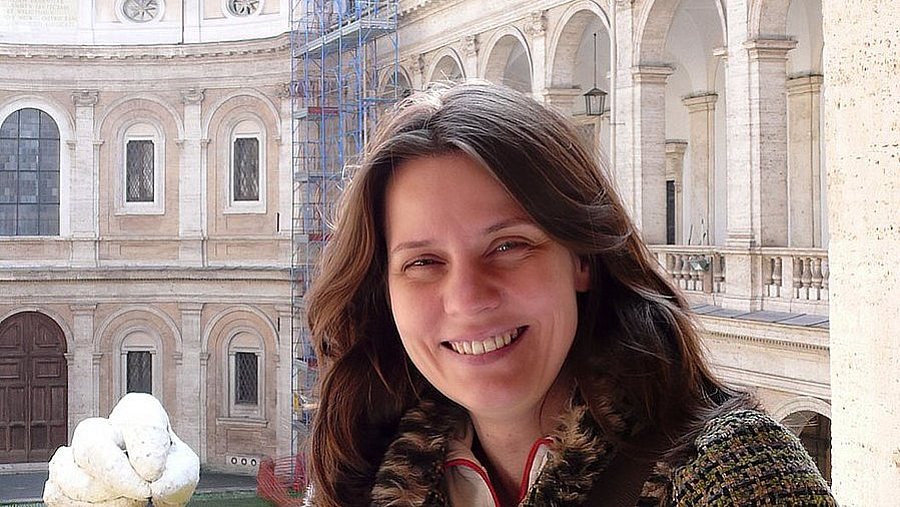
The Elberfeld Anniversary Fountain
Dr. Doris Lehmann / History of Art
Photo: Private
Too much 'Gemächt` on the stronger sex
Art historian Dr. Doris Lehmann on the Elberfeld Jubiläumsbrunnen/Neptune Fountain and its turbulent early years
In 2008, Guillaume Bijl's "A Successful Day," that upside-down bronze figure was erected at the Kasino traffic circle in Elberfeld, which had been damaged several times over the years. In 1959, citizens were angry with Henry Moore's "Sitting Man," tarred and feathered it, and regretted in a letter left behind that the figure would have been better made into 100 frying pans. In 1901, however, the male nudity on the newly erected Jubiläumsbrunnen/Neptune Fountain in the center of Elberfeld triggered a storm of indignation among church and society that went so far that the figures were even castrated. Art historian Doris Lehmann teaches at Bergische Universität and knows the turbulent history of the listed Elberfeld fountain.
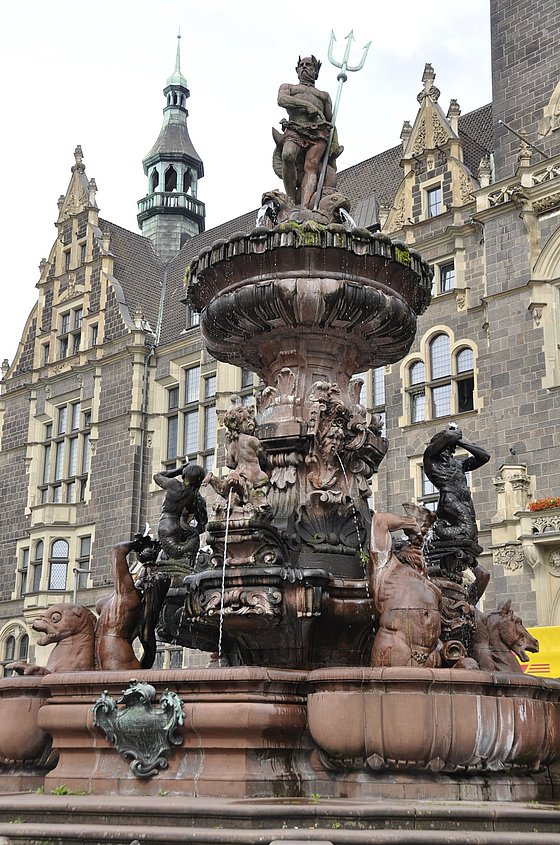
Jubilee Fountain
Photo: UniService Transfer
Fontana del Nettuno from Trento is model for Elberfeld fountain
The Jubiläumsbrunnen/Neptune Fountain was inaugurated in 1901. In Wilhelminian Elberfeld, the Verschönerungsverein donated this impressive fountain to the city of Elberfeld, which has a famous model. "The model for the fountain donated on the occasion of the 25th anniversary of the Verschönerungsverein in 1895 is the Fontana del Nettuno, designed by Francesco Antonio Giongo, which has stood in the cathedral square in Trento since 1769," explains the art lecturer. "This fountain of Neptune had been lavishly restored in 1865-73 by Andrea Malfatti, a highly esteemed sculptor in Italy at the time. When the Jubilee Fountain was planned in connection with the construction of the new Elberfeld City Hall, the fountain in Trento was still crowned by the original figure made by Stefano Salterio. Like the Neptune in Wuppertal, this was made of stone and was only removed from its place during the Second World War. Today it is located in the Castel Thun in Trentino. The fountain is now adorned by a bronze copy." Moreover, the Italian Neptune bears little resemblance to the Wuppertal figure, Lehmann explains. The prototype, he says, is much slimmer and turns elegantly around its body axis. "The Jubilee Fountain is also a free copy in other parts: one ingredient of the Düsseldorf sculptor are the faces placed in the cartouches on the fountain's shaft. The hair and beard costumes indicate that contemporaries were immortalized here."
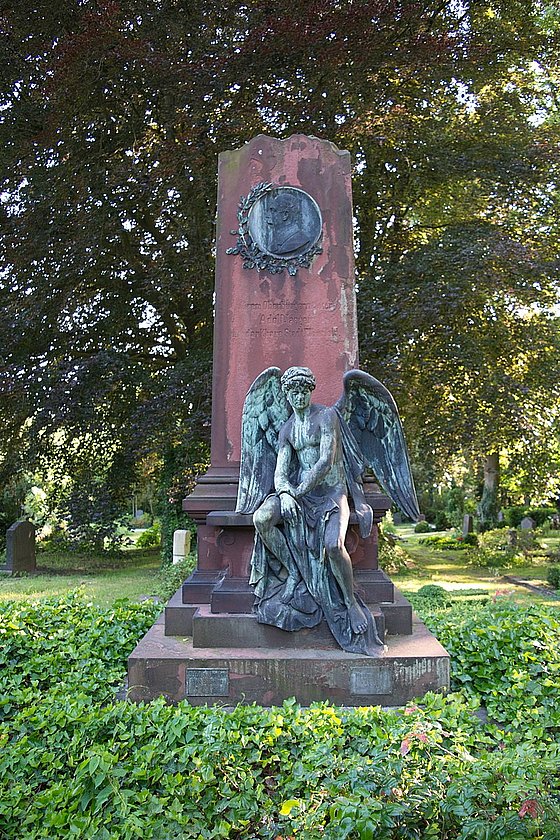
Tomb of Adolf Jäger, designed by Leo Müsch
Photo: CC BY-SA 4.0
Jubilee fountain in Wuppertal created by Leo Müsch
The commission for the Elberfeld fountain was given to the Düsseldorf sculptor Leo Müsch (1846 - 1911). "He was a native of Düsseldorf and learned sculpture from the academy professors there, Julius Bayerle and August Wittig," Lehmann recounts. "Müsch worked for a time in the studio of cathedral sculptor Christian Mohr in Cologne and took on various commissions in the Rhineland. Before he made the jubilee fountain, he had already made a bowl fountain for Corneliusplatz in Düsseldorf and decorated the Three Emperors Water Tower with portrait medallions in Cronenberg, which was still independent at the time. Some Wuppertalers will also be familiar with the tomb he created for the mayor of Elberfeld, Adolf Jaeger, who died in 1899."
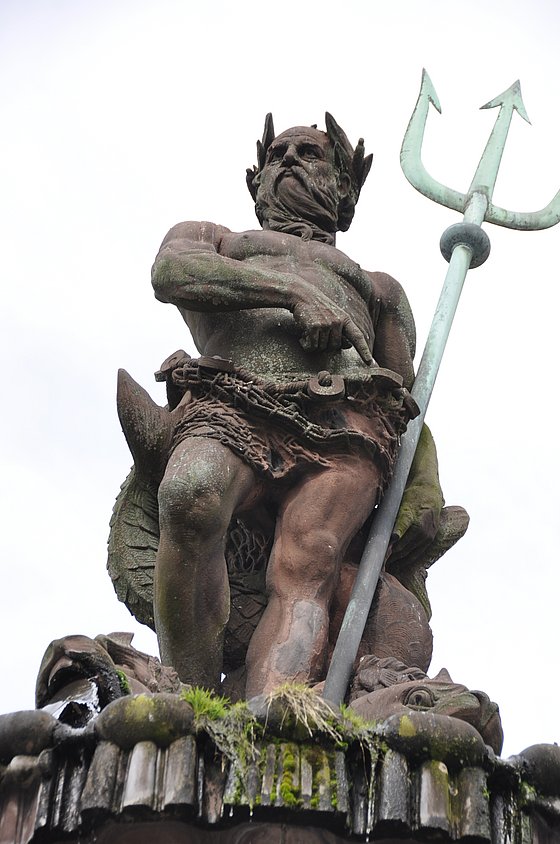
Anniversary fountain (detail - Neptune)
Photo: UniService Transfer
A fountain tells a story
The main figure embodies the Roman god Neptune, who was responsible for flowing waters in ancient times, Lehmann says, going on to explain the significance of the large-scale sculpture. "Neptune was the protector of the springs and thus also of our fountain. Neptune is recognizable by his trident and the muscular and bearded nude figure. Instead of the typical waistcoat, his loins are girded with a net, a reference to the trade of fishing. Unlike his predecessors in Florence, Bologna or Rome, our Wuppertal Neptune also wears a crown of reeds, an ancient marker for river gods. Neptune's appearance is accompanied by his entourage. This consists of beings, which were assigned to him and the element water since the antiquity. At his feet we recognize dolphins, of ancient design, representing his power over the sea. The fountain architecture is populated by mythical mixed beings with fish tails: Tritons (mixed creatures with human upper body and fish-like lower body) blowing shells, in the water of the fountain bowl cavorting sea centaurs (mixed creatures of horse and human) and Nereids (nymphs of the sea) riding horse- and panther-headed hippocamps (mythical creatures, in front horse behind fish). They illustrate lust for life and vitality that water brings forth. But the location near the new Elberfeld City Hall also points to Neptune's ability to smooth the waters in the community in his role as ruler." The architecture and the figures of the jubilee fountain are made of red Main sandstone, Lehmann knows, which comes from the Main quadrangle, where since the Middle Ages various types of stone were quarried in different quarries and shipped across the Main. In the second half of the 19th century, red Main sandstone was a popular material for representative purposes throughout the German Empire and beyond its borders. This can still be seen today, he said. "If you drive through the Rhine-Main area with your eyes open, you're bound to discover some buildings like this."
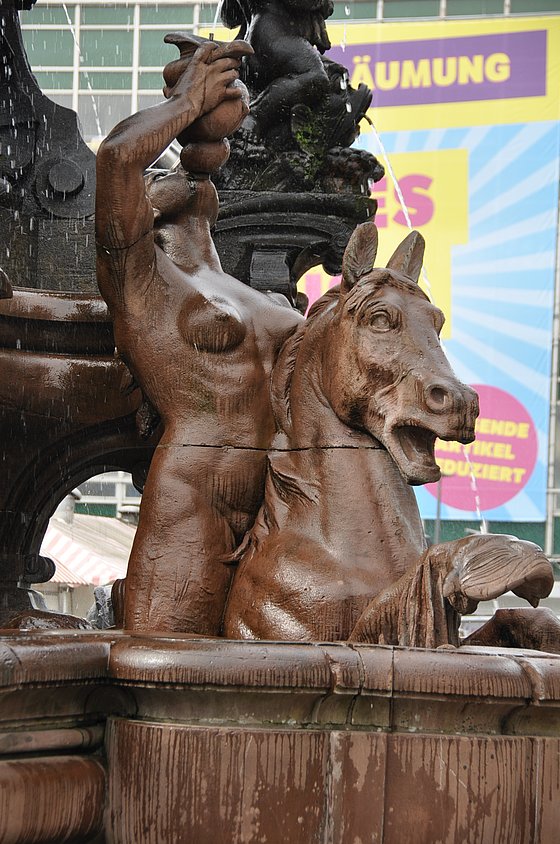
Jubilee fountain (detail - sea nymph)
Photo: UniService Transfer
Installation of the fountain triggered a storm of indignation
"The fountain figures were provocative at the time," Lehmann begins. "Around 1900, artistic freedom in Germany was very controversial and not yet legally secured. At that time, Wilhelm II attempted to eliminate general 'immorality` by radically tightening the already existing censorship. Based on a trial of a pimp who had committed a crime, the so-called 'Lex Heinze', initiated by the emperor, initially aimed to establish a basis in criminal law against pornography, procuring and theatrical performances that offended the sense of shame. The planned 'Art and Showcase Paragraph', however, even included the exhibition of depictions that could be construed as 'lewd' or even just likely to cause annoyance 'by grossly violating' the sense of shame and morality." This included all depictions of nudes and also modeling as a profession, which is why in 1900 satirical sheets caricatured the Venus de Milo and depictions of Adam and Eve being led away by policemen, for example. "We have to keep in mind that women in Germany didn't know bathing suits yet, but wore bathing dresses with leggings underneath," the art scholar explains. "The sight of male genitalia in a public square, even if they were components of idealized nude sculptures, accordingly attracted attention. A year earlier, Wilhelm II had personally inaugurated the town hall. There the uncovered nakednesses were a slap in the face of the guardians of morals." The fury of destruction was accordingly unleashed quickly. According to Lehmann: "The fountain was partially destroyed and censored by vandalism. Unknown persons cut off the controversial body parts of the figures."
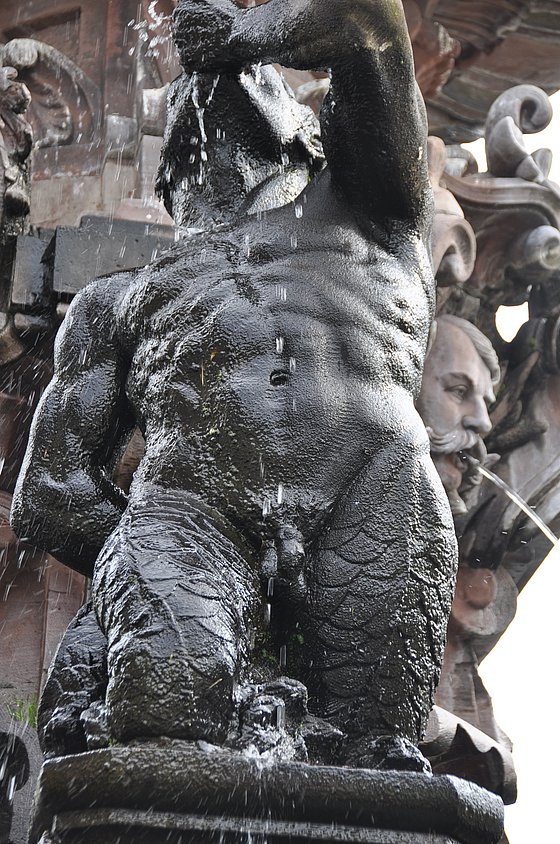
Anniversary Fountain (Detail - A Tritone)
Photo: UniService Transfer
Acanthus leaves cover the shame
As a consequence, there was no dedication ceremony and the artist restored the fountain figures by covering the damaged areas with acanthus leaves. But that was not enough. "The city council discussed whether the fountain should be completely removed, censored preserved or restored. In the end, it opted for the compromise of preserving the censored version. Our Neptune was in good company: Queen Victoria was so shocked by the nakedness of Michelangelo's David that the plaster cast she donated to the Museum of Decorative Arts in London in 1857 was covered with a specially made fig leaf - which can be removed again."
100 years later, art in public spaces is still at risk
After more than 100 years, tempers have calmed regarding the Jubilee Fountain. But art in public spaces is still a victim of vandalism today. "Today, the ideal acts, some of which are covered up, are tolerated; no one is calling for a restoration of the original condition and would certainly trigger new indignation," says Lehmann, because ultimately vandalism has many faces. "If the fountain basin is sprayed with paint, as was recently the case, or used as an ashtray or to dispose of waste, then that falls under vandalism just as much as the large amounts of washing or dishwashing detergent that are poured into fountains elsewhere. The result is not a fun foam party, but common damage to property, since in such a case not only the city center must be cleaned, but also thousands of liters of water and pipe systems must be cleaned with considerable effort and corresponding costs." Social control can curb this, he said, but not every monument in public space is guarded 24 hours a day. Therefore, education through good art education is important, Lehmann demands, so that open questions are clarified, awareness is created and appreciation and care arise from it. That protects in the long run. "But we should not be under the illusion that vandalism is our only problem. Works of visual art in public spaces can still provoke heated debate today, and censorship is considered by some to be a suitable means of driving nude depictions out of our lives as immoral. Whether it's the limb of Müsch's Neptune or Michelangelo's David, or the wide pelvis of Fritz During's Primavera: unlike algorithms, we should be able to distinguish art from pornography. Those who expect that art should only trigger feelings of well-being have not developed an understanding for the specific achievements of art, which have been fought for for centuries. Whether you secretly bash a work of art at night or try to hide it unnoticed, neither is covered by freedom of expression, and those who have an opinion and attitude can openly stand up for it instead of anonymously questioning the freedom of art."
Art keeps the mind busy
In the meantime, the Jubiläumsbrunnen has been entered in the city of Wuppertal's list of monuments as an outstanding example of the sculptural art of historicism. "Art in public spaces has a very high value for me," Lehmann explains in conclusion. "We are surrounded by it every day, whether we perceive it consciously or subliminally. It beautifies our everyday life in so many places and that does us good, makes us think and even if it's sometimes exhausting, art in public spaces keeps the spirit of our society on its toes."
Uwe Blass
Dr. Doris H. Lehmann is a trained photographer and studied art history, classical archaeology, provincial Roman archaeology, and Latin philology at the University of Cologne, where she received her doctorate in 2005. In 2018, she habilitated at the Rheinische Friedrich-Wilhelms-Universität Bonn with a thesis on the strategies of dispute of visual artists in the modern era and has been a private lecturer since then. Since October 2018, she has been teaching art history as a research associate at Bergische Universität.
